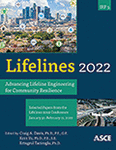Comparison of Traditional and Emerging Technologies for Assessing Slope Stability in an Urban Environment
Publication: Lifelines 2022
ABSTRACT
Quarrying operations between the late 19th and early 20th century transformed the once moderately rolling, stable eastern slope of San Francisco’s Telegraph Hill to a slope with near-vertical rock faces prone to rockslides. One such failure occurred following an intense rain event in December 2019 on a portion of slope directly beneath the Filbert Steps, a popular tourist attraction leading to the iconic Coit Tower. As part of the emergency response, geological mapping using three independent methods was performed. These methods were manual measurements using a geological compass, unmanned aerial system (UAS) data capture, and terrestrial Light Detection and Ranging (LiDAR) data capture. The results of this study showed structure from motion (SfM) models derived from UAS photogrammetry to be an effective method for characterizing a rock mass, capable of obtaining similar results to more expensive pieces of equipment (i.e., LiDAR) and eliminating the safety concerns associated with mapping unstable slopes using a geological compass. The large dataset of geological structure orientations obtained from the UAS imagery-based SfM model facilitated relatively robust analyses at an early stage in the project, and provided a basis for slope stabilization recommendations both for emergency response and permanent restoration. This paper presents a comparison of the three methods used for geological mapping and provides commentary on the effectiveness of UAS mapping for provision of efficient slope stabilization recommendations.
Get full access to this article
View all available purchase options and get full access to this chapter.
REFERENCES
Blake, M. C., Graymer, R. W., and Jones, D. L. (2000). “Geologic map and map database of parts of Marin, San Francisco, Alameda, Contra Costa, and Sonoma Counties, California.”, U.S. Geological Survey.
CCSF (City and County of San Francisco). (2019). “CCSF Employee Drone Policy,” Committee on Information Technology, https://sf.gov/sites/default/files/2021-05/CCSF_DronePolicy_2019_FINAL_0.pdf.
Sokol, N., Walker, M., Chew, R., and Baradaran, R. (2017). “Telegraph Hill Rock Slope Improvements.” American Rock Mechanics Association, 51st US Rock Mechanics/Geomechanics Symposium, Abstract 761, 25–28. June 2017.
United States Department of the Interior Bureau of Reclamation. (2014). Reclamation Safety and Health Standards. July.
Wallace, J. M., and Marcum, D. R. (2015). “History and Mechanisms of Rock Slope Instability along Telegraph Hill, San Francisco, California.” American Rock Mechanics Association, 49th US Rock Mechanics/Geomechanics Symposium, Abstract 820, 28 June-1. July 2015.
Wyllie, D. C., and Mah, C. (2004). Rock Slope Engineering. Civil and Mining. 4th Edition.
Information & Authors
Information
Published In
History
Published online: Nov 16, 2022
Authors
Metrics & Citations
Metrics
Citations
Download citation
If you have the appropriate software installed, you can download article citation data to the citation manager of your choice. Simply select your manager software from the list below and click Download.
